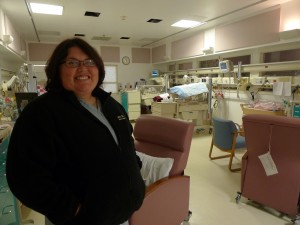Isidro speaks Mixteco, Spanish and a little English. But for the indigenous workers who don’t, there’s a major question: how do you get the right health care if you can’t communicate with doctors?
Isidro is actually part of the answer. As I described Friday on The California Report, she is one of 35 people, all of whom speak an indigenous language from Mexico, to be formally trained as medical interpreters at Natividad Medical Center in nearby Salinas.
Natividad is the region’s safety-net hospital meaning it provides cares for patients regardless of their ability to pay. In the hospital’s neonatal intensive care unit, I met Dr. Minerva Perez-Lopez, at the bedside of a baby girl who was just minutes old. Perez-Lopez is just one of the hospital's doctors who benefits from the language skills and training of Angelica Isidro and the other interpreters.
Perez-Lopez knows this hospital –- and the Salinas Valley –- well. She was born here, in the old building, and her father picked lettuce in the Salinas Valley for nearly 40 years. After growing up in Salinas, then going to college and medical school, Perez-Lopez came back and did her residency at Natividad. She joined the staff in 2006.
She was surprised when she started meeting patients from Mexico who didn’t speak Spanish. “I speak Spanish," she says she recalls thinking at the time. "I thought ‘I can go back to the town where I grew up. I can help patients, and everything will be a breeze.’”
She found, to her frustration, that she couldn’t always communicate with her patients.
Her own family history told her of the dangers of miscommunication. It was in the 1960s, at another hospital, and her Spanish-speaking mother gave birth to her brother. After taking the newborn away for a while, nurses accidentally brought back a different baby. Her mom couldn’t explain the mistake. Finally, after they checked the bandages, the nurses realized they had switched the babies.
It’s no wonder that Perez-Lopez finds comfort in the indigenous interpretation services. She remembers one patient, a woman whose uterine fibroids caused excessive bleeding. Perez-Lopez determined that the woman needed surgery but, like many indigenous people, her patient viewed surgery skeptically. Also, there are challenges with time off from work and insurance, especially for seasonal farmworkers. “Their concern is, ‘If I have surgery I can’t work for four or five weeks, I can’t feed my family. Let’s wait until I stop work,'" Perez-Lopez says.
Perez-Lopez was able to speak with her patient with the help of an indigenous interpreter, and the doctor and patient worked out a plan.
“She was able to get the care she needed at the time she needed,” says Perez-Lopez.
